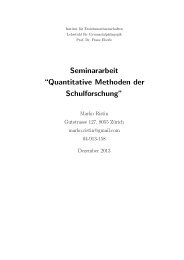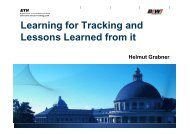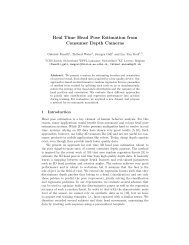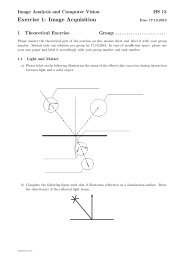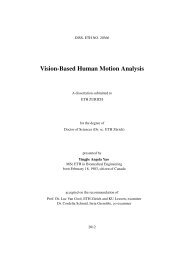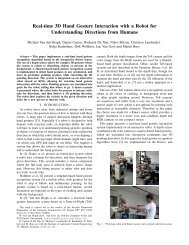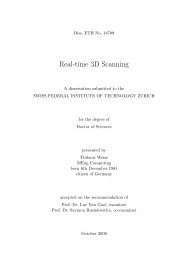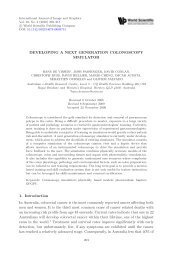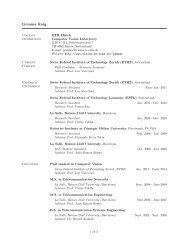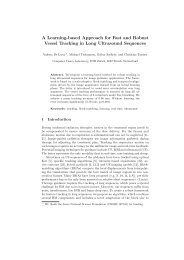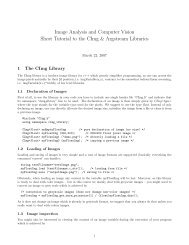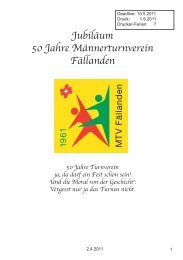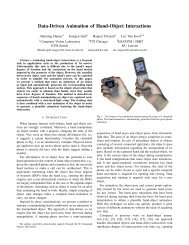Recognizing Cars in Aerial Imagery to Improve Orthophotos
Recognizing Cars in Aerial Imagery to Improve Orthophotos
Recognizing Cars in Aerial Imagery to Improve Orthophotos
You also want an ePaper? Increase the reach of your titles
YUMPU automatically turns print PDFs into web optimized ePapers that Google loves.
<strong>Recogniz<strong>in</strong>g</strong> <strong>Cars</strong> <strong>in</strong> <strong>Aerial</strong> <strong>Imagery</strong> <strong>to</strong> <strong>Improve</strong><br />
Orthopho<strong>to</strong>s<br />
Franz Leberl, Horst Bischof, Helmut Grabner, Stefan Kluckner<br />
Institute for Computer Graphics and Vision<br />
Graz University of Technology<br />
Inffeld. g. 16/II, A-8010 Graz, Austria<br />
{leberl,bischof,hgrabner,kluckner}@icg.tugraz.at<br />
ABSTRACT<br />
The au<strong>to</strong>matic creation of 3D models of urban spaces has become<br />
a very active field of research. This has been <strong>in</strong>spired<br />
by recent applications <strong>in</strong> the location-awareness on the Internet,<br />
as demonstrated <strong>in</strong> maps.live.com and similar websites.<br />
The level of au<strong>to</strong>mation <strong>in</strong> creat<strong>in</strong>g 3D city models has <strong>in</strong>creased<br />
considerably, and has benefited from an <strong>in</strong>crease <strong>in</strong><br />
the redundancy of the source imagery, namely digital aerial<br />
pho<strong>to</strong>graphy. In this paper we argue that the next big step<br />
forward is <strong>to</strong> replace pho<strong>to</strong>graphic texture by an <strong>in</strong>terpretation<br />
of what the texture describes, and <strong>to</strong> achieve this fully<br />
au<strong>to</strong>matically. One calls the result “semantic knowledge”.<br />
For example we want <strong>to</strong> know that a certa<strong>in</strong> part of the image<br />
is a car, a person, a build<strong>in</strong>g, a tree, a shrub, a w<strong>in</strong>dow,<br />
a door, <strong>in</strong>stead of just a collection of 3D po<strong>in</strong>ts or triangles<br />
with a superimposed pho<strong>to</strong>graphic texture. We <strong>in</strong>vestigate<br />
object recognition methods <strong>to</strong> make this next big step. We<br />
demonstrate an early result of us<strong>in</strong>g the on-l<strong>in</strong>e variant of<br />
a Boost<strong>in</strong>g algorithm <strong>to</strong> <strong>in</strong>deed detect cars <strong>in</strong> aerial digital<br />
imagery <strong>to</strong> a satisfac<strong>to</strong>ry and useful level of completeness.<br />
And we show that we can use this semantic knowledge <strong>to</strong><br />
produce improved orthopho<strong>to</strong>s. We expect that also the 3D<br />
models will be improved by the knowledge of cars.<br />
1. INTRODUCTION<br />
The systematic creation of models of the real world <strong>to</strong> support<br />
the locational awareness on the Internet, or <strong>to</strong> grow<br />
the current 2D approach <strong>to</strong> car navigation <strong>in</strong><strong>to</strong> a full 3-D<br />
experience, is an expensive proposition if based on manual<br />
methods. This motivates the work <strong>to</strong> replace such massive<br />
labor by au<strong>to</strong>mated procedures. Systems that are currently<br />
be<strong>in</strong>g set up <strong>to</strong> produce 3D urban models for Internet applications<br />
can rely on a rich literature, a great variety of<br />
methods and academic projects that demonstrate fully au<strong>to</strong>matic<br />
approaches <strong>to</strong> 3D reconstruction by shape-from-stereo<br />
or laser scann<strong>in</strong>g, e.g. [26].<br />
In recent years our team has <strong>in</strong>spired the development of a<br />
fully au<strong>to</strong>mated work-flow <strong>to</strong> recover 3D city models from<br />
highly overlapp<strong>in</strong>g aerial images produced by the UltraCam<br />
from Microsoft Pho<strong>to</strong>grammetry (formerly Vexcel Imag<strong>in</strong>g).<br />
In its most recent <strong>in</strong>carnation, each UltraCam-image resolves<br />
14, 430×9, 420 pixels. Success <strong>in</strong> the robust au<strong>to</strong>matic<br />
process<strong>in</strong>g of the data depends on a high <strong>in</strong>ter-image redundancy<br />
based on an 80% along-track overlap, thus with<strong>in</strong> an<br />
<strong>in</strong>dividual flight l<strong>in</strong>e, and a 60% across-track, thus from one<br />
flight l<strong>in</strong>e <strong>to</strong> the next. In much of our work, we employ a<br />
ground sampl<strong>in</strong>g distance (GSD) for the digital aerial images<br />
at approximately 8 cm. At this GSD a typical car gets<br />
imaged on<strong>to</strong> 35 × 70 pixels.<br />
Intermediate data sets get computed consist<strong>in</strong>g of a Digital<br />
Surface Model (DSM) of the terra<strong>in</strong>, which then gets<br />
separated <strong>in</strong><strong>to</strong> the “Bald Earth” (a Digital Terra<strong>in</strong> Model<br />
DTM) represent<strong>in</strong>g the terra<strong>in</strong> off which the vertical objects<br />
get stripped, as well as those vertical objects themselves.<br />
The data exist <strong>in</strong> the form of “po<strong>in</strong>t clouds”. Associated<br />
with the po<strong>in</strong>ts, or triangles formed from the po<strong>in</strong>ts, are<br />
patches of pho<strong>to</strong> texture. From those <strong>in</strong>termediate results,<br />
one builds both the 2-dimensional orthopho<strong>to</strong>s as well as the<br />
3-dimensional “city models”. The orthopho<strong>to</strong>s are created<br />
by project<strong>in</strong>g the pho<strong>to</strong> texture either on<strong>to</strong> the Bald Earth<br />
DTM for so-called “Traditional Ortho Pho<strong>to</strong>s” or on<strong>to</strong> the<br />
DSM <strong>to</strong> produce a so-called“True”or“Reflective Surface Ortho<br />
Pho<strong>to</strong>”. The 2-dimensional ortho pho<strong>to</strong>s provide a simpler<br />
data structure, smaller data volume and a great ease of<br />
use and orientation. By contrast, the 3-dimensional models<br />
consist of more data, need a more complex data structure<br />
and are more difficult <strong>to</strong> use and navigate. Therefore all<br />
location-aware web sites offer imagery <strong>in</strong> the form of 2D<br />
orthopho<strong>to</strong>s.<br />
In this paper, we want <strong>to</strong> go a step further and develop<br />
semantic knowledge about the objects <strong>in</strong> the terra<strong>in</strong>, and<br />
<strong>in</strong>itially use that knowledge <strong>to</strong> affect the orthopho<strong>to</strong>s. In<br />
subsequent steps, we will use that knowledge also <strong>to</strong> improve<br />
the 3-dimensional city models.<br />
The paper is structured as follows. We first review the 3D<br />
city model<strong>in</strong>g approach <strong>in</strong><strong>to</strong> which the semantic knowledge<br />
needs <strong>to</strong> be fed. Then we address object recognition <strong>in</strong> aerial<br />
images, and <strong>in</strong> subsection 3.2 we <strong>in</strong>troduce an on-l<strong>in</strong>e Boost<strong>in</strong>g<br />
variant. In section 4 we demonstrate an <strong>in</strong>itial application<br />
of this semantic knowledge creation <strong>to</strong> detect cars. We<br />
also demonstrate how the removal of cars from an aerial image<br />
improves the 2-dimensional visualization <strong>in</strong> the form of<br />
an orthopho<strong>to</strong>. We will f<strong>in</strong>ally conclude that the method
produces reliable and accurate results that outperform a<br />
manual approach of car detection and removal.<br />
2. CURRENT 3D CITY MODEL GENERA-<br />
TION<br />
2.1 Camera Station Information<br />
The current approach of city model<strong>in</strong>g starts with a block<br />
of overlapp<strong>in</strong>g aerial pho<strong>to</strong>graphs, typically obta<strong>in</strong>ed from<br />
a series of parallel flight l<strong>in</strong>es, each represent<strong>in</strong>g a so-called<br />
“strip” of overlapp<strong>in</strong>g images. The coord<strong>in</strong>ates and attitude<br />
of each camera station (thus the exterior orientation) are<br />
computed by an au<strong>to</strong>matic process that searches for a great<br />
number of tie-po<strong>in</strong>ts among overlapp<strong>in</strong>g images, perhaps<br />
10,000 <strong>in</strong> a s<strong>in</strong>gle image, and then computes the exterior<br />
orientation from the geometry of the image block. This relies<br />
on “redundancy”not only by image overlap, but also by<br />
the use of a very high number of tie po<strong>in</strong>ts. The approach<br />
is described <strong>in</strong> [28].<br />
2.2 Surface Model<strong>in</strong>g<br />
The computed camera orientation parameters feed <strong>in</strong><strong>to</strong> an<br />
area based image match<strong>in</strong>g algorithm <strong>to</strong> produce a dense<br />
range patch for each of the <strong>in</strong>put images. Those patches<br />
then get converted <strong>in</strong><strong>to</strong> a seamless digital surface model<br />
DSM. The particular implementation of the approach has<br />
been described by [11]. The range images are computed<br />
from three <strong>in</strong>put images (a reference image and its two immediate<br />
neighbors) us<strong>in</strong>g a plane sweep<strong>in</strong>g approach. The<br />
plane sweep uses the normalized cross correlation as similarity<br />
measure and produces a so-called 3D depth space which<br />
conta<strong>in</strong>s the depth hypotheses and their associated correlation<br />
values. The f<strong>in</strong>al range image is computed us<strong>in</strong>g a semiglobal<br />
optimization approach proposed by [11]. It employs<br />
a redundant and overlapp<strong>in</strong>g set of patches, each derived<br />
from an image triplet. Given an 80% forward-overlap, each<br />
ground po<strong>in</strong>t will be imaged on<strong>to</strong> 5 images. This overlap<br />
results <strong>in</strong> three image triplets per ground po<strong>in</strong>t, ready <strong>to</strong><br />
get merged.<br />
2.3 Creat<strong>in</strong>g Data Products <strong>in</strong> 2D and 3D<br />
Comb<strong>in</strong><strong>in</strong>g the result<strong>in</strong>g terra<strong>in</strong> surface with the image textures<br />
produces a result as shown <strong>in</strong> Figure 1. The actual<br />
work-flow is fairly complex and <strong>in</strong>cludes a separation of the<br />
surface data <strong>in</strong><strong>to</strong> the Bald Earth and its vertical objects,<br />
and the po<strong>in</strong>t clouds do get triangulated and th<strong>in</strong>ned out<br />
<strong>to</strong> be acceptable <strong>in</strong> an Internet application. At this time,<br />
the methods have advanced <strong>to</strong> the po<strong>in</strong>t where data can get<br />
produced fully au<strong>to</strong>matically, and with m<strong>in</strong>imal need for<br />
manual edits.<br />
2.4 Add<strong>in</strong>g Semantic Knowledge<br />
The drawback of these au<strong>to</strong>matic reconstruction methods<br />
is that only po<strong>in</strong>t-clouds (converted <strong>in</strong><strong>to</strong> triangles) and textured<br />
3D models are provided which do not present any<br />
semantic <strong>in</strong>formation. Therefore, we cannot query the data<br />
sets accord<strong>in</strong>g <strong>to</strong> content nor can we produce specific thematic<br />
maps of specific object classes. In order <strong>to</strong> have a<br />
proper <strong>in</strong>terpretation of the scene and <strong>to</strong> build better 3D<br />
models higher level knowledge about the object is required.<br />
This has been recognized by recent research work, for example<br />
[5, 8]. We believe that semantic <strong>in</strong>formation can be<br />
Figure 1: Au<strong>to</strong>matically generated 3D model from a<br />
part of Graz. The entire model encompasses 493098<br />
triangles. The image block consists of 155 aerial pho<strong>to</strong>graphs<br />
taken with the UltraCam D camera. Courtesy<br />
Microsoft-Virtual Earth, K. Karner.<br />
extracted fairly reliably, and that this <strong>in</strong>creases the usefulness<br />
and value of the data tremendously.<br />
Let us therefore proceed with a presentation of a promis<strong>in</strong>g<br />
method for object detection applicable <strong>to</strong> aerial images, and<br />
show how this affects the 2-dimensional orthopho<strong>to</strong>s., us<strong>in</strong>g<br />
the example of cars. Not only do we need <strong>to</strong> recognize cars,<br />
but we also need <strong>to</strong> remove them from the image and replace<br />
the image texture by <strong>in</strong>pa<strong>in</strong>ted texture.<br />
3. OBJECT DETECTION<br />
3.1 Background<br />
In terra<strong>in</strong> images, we have permanent objects that we want<br />
<strong>to</strong> represent <strong>in</strong> a location-aware system. However, we also<br />
have objects that are irrelevant because they are not a permanent<br />
feature of the terra<strong>in</strong>. This <strong>in</strong>cludes cars and people.<br />
We <strong>in</strong>itially focus on cars, although considerable work<br />
has been done already <strong>to</strong> detect faces [22, 25], or pedestrians<br />
[17], cars [1], bikes [15], and other visual objects. One<br />
sometimes denotes this as a “visual categorization” as opposed<br />
<strong>to</strong> “object recognition” [7, 15]. See [19] for a recent<br />
overview of research <strong>in</strong> the area of visual categorization.<br />
The predom<strong>in</strong>ant paradigm for object detection is now based<br />
on classification approaches which scan the whole image by<br />
slid<strong>in</strong>g a w<strong>in</strong>dow over it, at different resolutions, <strong>to</strong> extract<br />
features such as edges, corners, texture, and classify this<br />
w<strong>in</strong>dow as one conta<strong>in</strong><strong>in</strong>g the object of <strong>in</strong>terest or not. Usually<br />
some post-process<strong>in</strong>g by a local maxima search or similar<br />
approaches is necessary <strong>to</strong> avoid multiple detections.<br />
At the core of these object detection approaches is a classifier,<br />
e.g., AdaBoost [9], W<strong>in</strong>now [13], neural network [22]<br />
or support vec<strong>to</strong>r mach<strong>in</strong>e [24]. The proposed approaches<br />
have achieved considerable success <strong>in</strong> the above mentioned<br />
applications. We present <strong>in</strong> this paper an approach that follows<br />
this paradigm; as classifier we use an on-l<strong>in</strong>e variant of<br />
Boost<strong>in</strong>g [10] <strong>to</strong> be described <strong>in</strong> the next section.
conf(x) is bounded by [−1, 1], therefore we <strong>in</strong>terpret it as a<br />
confidence measure of the strong classifier.<br />
Similarly, we can apply Boost<strong>in</strong>g for feature selection, as<br />
<strong>in</strong>troduced by Tieu and Viola [23]. The basic idea is that<br />
each feature (<strong>to</strong>gether with a threshold that is tra<strong>in</strong>ed) corresponds<br />
<strong>to</strong> a weak classifier. The application of Boost<strong>in</strong>g<br />
<strong>to</strong> these features gets us an <strong>in</strong>formative feature subset.<br />
The tra<strong>in</strong><strong>in</strong>g for feature selection proceeds <strong>in</strong> a manner similar<br />
<strong>to</strong> the described algorithm. From a set of possible features<br />
F = {f 1, ..., f k }, and at iteration n the best feature<br />
forms a weak classifier h weak<br />
n which corresponds <strong>to</strong> the selected<br />
feature f n. The weights of the tra<strong>in</strong><strong>in</strong>g samples are<br />
updated with respect <strong>to</strong> the error of the chosen classifier.<br />
Figure 2: A w<strong>in</strong>dow of 600 × 600 pixels taken from<br />
a test area consist<strong>in</strong>g of 4500 × 4500 pixels. The red<br />
rectangles represent the manually developed ground<br />
truth.<br />
3.2 Boost<strong>in</strong>g<br />
Boost<strong>in</strong>g is a classifier comb<strong>in</strong>ation method, which comb<strong>in</strong>es<br />
several “weak” classifiers <strong>to</strong> form a “strong” one. Many researchers<br />
have analyzed and applied Boost<strong>in</strong>g for different<br />
tasks. There are many different variants of Boost<strong>in</strong>g which<br />
have been proposed (e.g. Real-Boost [9] and LP-Boost [6]).<br />
We use the discrete AdaBoost algorithm, proposed by Freund<br />
and Schapire [9].<br />
The algorithm works as follows: We have a tra<strong>in</strong><strong>in</strong>g set<br />
X = {〈x 1, y 1〉, ..., 〈x L, y L〉 | x i ∈ R m , y i ∈ {−1,+1}} with<br />
positive and negative labeled samples and an <strong>in</strong>itial uniform<br />
distribution p(x i ) = 1 over the examples. A weak classifier<br />
L<br />
h weak is tra<strong>in</strong>ed us<strong>in</strong>g X and p(x). We only require that the<br />
weak classifier perform slightly better than random guess<strong>in</strong>g.<br />
Therefore, for a b<strong>in</strong>ary decision task the error rate of the<br />
classifier must be less than 50%. The weak classifier h weak<br />
n<br />
´, where en denotes the<br />
then gets a weight α n = 1 · ln `1−e n<br />
2 e n<br />
error of the classifier. Depend<strong>in</strong>g on the performance of the<br />
weak classifier, the probability p(x) gets updated. For misclassified<br />
samples, the correspond<strong>in</strong>g weight gets <strong>in</strong>creased,<br />
while for correctly classified samples the weight is decreased.<br />
As a consequence the algorithm focuses on examples that are<br />
difficult <strong>to</strong> learn. This process gets iterated. A new weak<br />
classifier is added at each Boost<strong>in</strong>g iteration until a certa<strong>in</strong><br />
s<strong>to</strong>pp<strong>in</strong>g criterion is met.<br />
From the result<strong>in</strong>g set of N weak classifiers h weak<br />
n (x), a<br />
strong classifier h strong (x) is generated, by a l<strong>in</strong>ear comb<strong>in</strong>ation:<br />
conf(x) =<br />
P N<br />
n=1<br />
αn · hweak n<br />
(x)<br />
P N<br />
(1)<br />
n=1 αn<br />
h strong (x) = sign(conf(x)) (2)<br />
3.2.1 On-l<strong>in</strong>e Boost<strong>in</strong>g for Feature Selection<br />
Feature selection via Boost<strong>in</strong>g needs all tra<strong>in</strong><strong>in</strong>g samples <strong>to</strong><br />
be available <strong>in</strong> advance. We use an on-l<strong>in</strong>e feature selection<br />
algorithm [10], based on an on-l<strong>in</strong>e version of AdaBoost [16].<br />
This requires <strong>to</strong> each boost<strong>in</strong>g step <strong>to</strong> be performed on-l<strong>in</strong>e.<br />
The basic idea of on-l<strong>in</strong>e Boost<strong>in</strong>g is <strong>to</strong> estimate the difficulty<br />
of a sample by propagat<strong>in</strong>g it through the set of weak<br />
classifiers. This can be <strong>in</strong>terpreted as model<strong>in</strong>g the <strong>in</strong>formation<br />
ga<strong>in</strong> with respect <strong>to</strong> the first n classifiers and code it by<br />
an importance fac<strong>to</strong>r λ for do<strong>in</strong>g the update of the n + 1-th<br />
weak classifier. As proven <strong>in</strong> [16] the result of the classifier<br />
us<strong>in</strong>g on-l<strong>in</strong>e Boost<strong>in</strong>g converges statistically <strong>to</strong> the one<br />
obta<strong>in</strong>ed by off-l<strong>in</strong>e Boost<strong>in</strong>g as the number of iterations<br />
N → ∞. When presented the same tra<strong>in</strong><strong>in</strong>g set multiple<br />
times, on-l<strong>in</strong>e and off-l<strong>in</strong>e Boost<strong>in</strong>g achieve the same results.<br />
For select<strong>in</strong>g features by on-l<strong>in</strong>e Boost<strong>in</strong>g, “selec<strong>to</strong>rs” are <strong>in</strong>troduced.<br />
On-l<strong>in</strong>e Boost<strong>in</strong>g is then not directly performed<br />
on the weak classifiers, but on the selec<strong>to</strong>rs. For that purpose,<br />
a selec<strong>to</strong>r h sel (x) consists of a set of M weak classifiers<br />
{h weak<br />
1 (x), . . . , h weak (x)} and selects the one with m<strong>in</strong>imal<br />
error.<br />
M<br />
“<br />
h sel (x) = arg m<strong>in</strong> e<br />
m<br />
h weak<br />
m<br />
”<br />
(x)<br />
When tra<strong>in</strong><strong>in</strong>g a selec<strong>to</strong>r, its M weak classifiers are tra<strong>in</strong>ed<br />
and the one with the lowest estimated error is selected.<br />
Therefore, a selec<strong>to</strong>r can also be seen as a classifier which<br />
switches between the weak classifiers. As <strong>in</strong> the off-l<strong>in</strong>e case,<br />
each weak classifier corresponds <strong>to</strong> a s<strong>in</strong>gle feature, i.e. the<br />
hypothesis generated by the weak classifier is based on the<br />
response of the feature.<br />
The on-l<strong>in</strong>e AdaBoost tra<strong>in</strong><strong>in</strong>g algorithm used for feature<br />
selection proceeds as follows: A fixed number of N selec<strong>to</strong>rs<br />
h sel<br />
1 , .., h sel<br />
N is <strong>in</strong>itialized with random features. The selec<strong>to</strong>rs<br />
and the correspond<strong>in</strong>g vot<strong>in</strong>g weights α n are updated,<br />
as soon as a new tra<strong>in</strong><strong>in</strong>g sample 〈x,y〉 is available. The<br />
weak classifier with the smallest estimated error is selected<br />
<strong>in</strong> each selec<strong>to</strong>r. For updat<strong>in</strong>g the weak classifier one can use<br />
any on-l<strong>in</strong>e learn<strong>in</strong>g algorithm. F<strong>in</strong>ally, the weight λ n of the<br />
sample is updated and passed <strong>to</strong> the next selec<strong>to</strong>r h sel<br />
n+1. The<br />
weight is <strong>in</strong>creased if the sample is misclassified by the current<br />
selec<strong>to</strong>r or decreased otherwise. A l<strong>in</strong>ear comb<strong>in</strong>ation<br />
(3)
of the N selec<strong>to</strong>rs gives the strong classifier:<br />
“ P N<br />
h strong n=1<br />
αn · hsel n (x)<br />
”<br />
(x) = sign P N<br />
n=1 αn<br />
For more details see [10].<br />
(4)<br />
<strong>in</strong>teractive learn<strong>in</strong>g process. This process permits us <strong>to</strong> update<br />
the parameters of the classifier <strong>in</strong> a greedy manner with<br />
respect <strong>to</strong> m<strong>in</strong>imiz<strong>in</strong>g the detection error. This results <strong>in</strong><br />
very fast tra<strong>in</strong><strong>in</strong>g with a m<strong>in</strong>imum number of samples (see<br />
experimental results). It avoids label<strong>in</strong>g redundant samples<br />
that do not contribute <strong>to</strong> the current decision boundary.<br />
3.2.2 Image Features<br />
Us<strong>in</strong>g features <strong>in</strong>stead of raw pixel values <strong>in</strong>creases the robustness<br />
and <strong>in</strong>tegrates <strong>in</strong>variance <strong>in</strong> the classifier. In pr<strong>in</strong>ciple<br />
we can choose among many different features, but s<strong>in</strong>ce<br />
we are work<strong>in</strong>g with large images, and s<strong>in</strong>ce these large images<br />
need <strong>to</strong> be scanned by the classifier we look for features<br />
that can be computed quickly, for example by means of an<br />
<strong>in</strong>tegral image [25]. Our choices are Haar-like features [25],<br />
orientation his<strong>to</strong>grams [12, 20] and a simplified version of<br />
local b<strong>in</strong>ary patterns [14].<br />
3.2.3 Object Recognition versus Classical “Classification”<br />
Classification of pixels or pixel groups is part of a standard<br />
3D city model<strong>in</strong>g system [28]. The image content gets separated<br />
<strong>in</strong><strong>to</strong> regions that typically describe build<strong>in</strong>g roofs, circulation<br />
spaces such as streets and park<strong>in</strong>g areas or driveways,<br />
vegetation, grass surfaces and water. Classification<br />
results feed <strong>in</strong><strong>to</strong> the separation of vertical objects from the<br />
Bald Earth, <strong>to</strong> name an example.<br />
However, “object recognition” differs from “classification” <strong>in</strong><br />
its goal. The goal of object recognition is <strong>to</strong> describe and<br />
detect an object as a whole, tak<strong>in</strong>g <strong>in</strong><strong>to</strong> account its texture<br />
and shape. Classification is pixel oriented, a s<strong>in</strong>gle pixel or<br />
a pixel and its neighborhood are the <strong>in</strong>put and a class label<br />
for a s<strong>in</strong>gle pixel is the output. Nevertheless these processes<br />
may support each other as we discuss later.<br />
4. CAR DETECTION AND REMOVAL<br />
4.1 Tra<strong>in</strong><strong>in</strong>g<br />
The most important element for success <strong>in</strong> car detection is<br />
<strong>to</strong> properly tra<strong>in</strong> the classifier. This classification problem is<br />
treated as a b<strong>in</strong>ary problem, car versus background. Usually<br />
this requires a large amount of pre-labeled data, perhaps <strong>in</strong><br />
the order of ten-thousand images. However s<strong>in</strong>ce we have<br />
an on-l<strong>in</strong>e learn<strong>in</strong>g method which is sufficiently fast for <strong>in</strong>teractive<br />
work, we attack tra<strong>in</strong><strong>in</strong>g as an <strong>in</strong>teractive learn<strong>in</strong>g<br />
problem. The key idea is that the user has <strong>to</strong> label only those<br />
examples that are not correctly classified by the current classifier.<br />
In fact, it has been shown by the active learn<strong>in</strong>g community<br />
[18] that it is more effective (<strong>in</strong>crease the learn<strong>in</strong>g<br />
speed, or m<strong>in</strong>imize the number of labeled samples) <strong>to</strong> sample<br />
at the current estimate of the decision boundary than at<br />
the unknown true boundary. This is exactly the approach<br />
we are follow<strong>in</strong>g.<br />
We evaluate the current classifier on an image. The human<br />
supervisor labels additionally “<strong>in</strong>formative” samples,<br />
e.g. marks a wrongly labeled example which can either be a<br />
false detection or a missed car. The new updated classifier<br />
gets applied aga<strong>in</strong> on the same image or on a new image,<br />
and the process cont<strong>in</strong>ues iteratively until a satisfac<strong>to</strong>ry detection<br />
performance is achieved. This is a fully supervised<br />
4.2 Detection<br />
After tra<strong>in</strong><strong>in</strong>g, detection results from the exhaustive application<br />
of the tra<strong>in</strong>ed classifier on the images. S<strong>in</strong>ce we know<br />
the resolution of the image we do not need <strong>to</strong> search cars<br />
at various scales. However, we need <strong>to</strong> cope with the car’s<br />
orientation and therefore do search cars at different image<br />
rotations. Instead of tra<strong>in</strong><strong>in</strong>g the classifier with different<br />
orientations we tra<strong>in</strong> it at one canonical orientation, and<br />
evaluate it by rotat<strong>in</strong>g the image with 15 degree <strong>in</strong>crements.<br />
An option exists <strong>to</strong> have the detec<strong>to</strong>r be rotated by comput<strong>in</strong>g<br />
the features at different angles for the detection process.<br />
The most efficient approach is the use of features that can<br />
be rotated quickly. A car is considered <strong>to</strong> be detected if the<br />
output confidence value of the classifier is above a threshold,<br />
i.e. zero. The lower the threshold, the more likely an<br />
object is detected as a car, but on the other hand the more<br />
likely a false positive will occur 1 . Us<strong>in</strong>g just a simple threshold<br />
results <strong>in</strong> many overlapp<strong>in</strong>g detections. Therefore, post<br />
process<strong>in</strong>g ref<strong>in</strong>es and comb<strong>in</strong>es these outputs.<br />
(a)<br />
(b)<br />
Figure 3: Some positive (a) and negative (b) examples<br />
that have been labeled by the human dur<strong>in</strong>g<br />
the tra<strong>in</strong><strong>in</strong>g process of the classifier.<br />
4.3 Post Process<strong>in</strong>g<br />
For post process<strong>in</strong>g we could use non-maximum suppression.<br />
A slight improvement of the localization can get achieved<br />
us<strong>in</strong>g the mean-shift algorithm [4]. The confidence values<br />
of the classifier are an <strong>in</strong>put <strong>to</strong> the mean shift procedure.<br />
The mean shift algorithm is non-parametric and iteratively<br />
locates density extrema or modes of a given distribution.<br />
We rely on a Gaussian kernel, its width is related <strong>to</strong> the size<br />
of the car. Start<strong>in</strong>g from an <strong>in</strong>itial location the local mean<br />
shift vec<strong>to</strong>r maximizes the underly<strong>in</strong>g probability density<br />
function <strong>in</strong> a gradient descent manner.<br />
For additional improvements of the detection result, we like<br />
<strong>to</strong> use additional context <strong>in</strong>formation such as the street layer<br />
from a standard pixel based classification us<strong>in</strong>g support vec<strong>to</strong>r<br />
mach<strong>in</strong>es, as mentioned <strong>in</strong> section 3.5 and reviewed <strong>in</strong><br />
[28])<br />
1 For car removal we can accept some false detections because<br />
<strong>in</strong> most cases the <strong>in</strong>pa<strong>in</strong>t<strong>in</strong>g procedure will not change the<br />
image anyway <strong>in</strong> a significant manner
4.4 Remov<strong>in</strong>g <strong>Cars</strong> and Texture In Pa<strong>in</strong>t<strong>in</strong>g<br />
The detected cars need <strong>to</strong> get removed from the images. A<br />
procedure is needed <strong>to</strong> avoid visual artifacts where texture<br />
is now miss<strong>in</strong>g. Insert<strong>in</strong>g plausible values is be<strong>in</strong>g achieved<br />
by a process called “<strong>in</strong>pa<strong>in</strong>t<strong>in</strong>g”. Many different approaches<br />
for <strong>in</strong>pa<strong>in</strong>t<strong>in</strong>g have been developed. We use a variant based<br />
on m<strong>in</strong>imiz<strong>in</strong>g an energy functional referred <strong>to</strong> as <strong>to</strong>tal variation<br />
[3]. We obta<strong>in</strong> satisfac<strong>to</strong>ry results with no obvious visual<br />
artifacts. More sophisticated <strong>in</strong>pa<strong>in</strong>t<strong>in</strong>g methods could<br />
be used also, such as [2] or methods based on graph-cuts.<br />
5. EXPERIMENTAL RESULTS<br />
The experiments serve <strong>to</strong> assess and demonstrate the efficiency<br />
of the on-l<strong>in</strong>e tra<strong>in</strong><strong>in</strong>g and robustness of our framework<br />
for car detection from aerial images. They also demonstrate<br />
the successful removal of cars from the images and<br />
their replacement by generic texture for use <strong>in</strong> 2-dimensional<br />
orthopho<strong>to</strong>s.<br />
5.1 Accuracy measures<br />
For a quantitative evaluation, we use so-called recall-precision<br />
curves (RPC) [1]. We manually establish a reference set of<br />
cars, represent<strong>in</strong>g the ground truth with #nP cars. Of the<br />
<strong>to</strong>tal detected cars, #TP are the true positives and #FP<br />
the false positives. The precision rate (PR) shows the accuracy<br />
of the prediction of the positive class. The recall rate<br />
(RR) shows how many of the known <strong>to</strong>tal number of positive<br />
samples we are able <strong>to</strong> identify. The F-Measure (Fm) is<br />
the harmonic mean between RR and PR , a type of average<br />
between recall and precision rate. For a visual evaluation of<br />
the detec<strong>to</strong>r, we plot RR aga<strong>in</strong>st 1 − PR.<br />
Figure 4: Performance of the tra<strong>in</strong>ed classifier versus<br />
tra<strong>in</strong><strong>in</strong>g time.<br />
#TP<br />
PR =<br />
#TP + #FP<br />
RR = #TP<br />
#nP<br />
2 · RR · PR<br />
Fm =<br />
RR + PR<br />
(5)<br />
(6)<br />
(7)<br />
What is a “correct detection”? We accept a detection as<br />
“correct” if and only if the center of the detection corresponds<br />
<strong>to</strong> the annotated ground truth car with a maximum<br />
city block distance of approximately 1.8m (represent<strong>in</strong>g 22<br />
pixels <strong>in</strong> the example images). In addition we require that<br />
the detected orientation be with<strong>in</strong> 16 degrees of the ground<br />
truth. These values rema<strong>in</strong> constant for all experiments.<br />
5.2 Data Set<br />
Our <strong>in</strong>itial experience is with aerial pho<strong>to</strong>graphy of the Graz<br />
city center (Austria). The images were acquired by the<br />
UltraCam D digital aerial camera developed by Microsoft<br />
Pho<strong>to</strong>grammetry. This camera produces 4 color channels <strong>in</strong><br />
red-green-blue-near <strong>in</strong>frared, and the images used <strong>in</strong>itially<br />
are at a ground resolution of 8 cm. The radiometry is presented<br />
with 16 bit per color channel, with a verified range<br />
between 12 and 13 bit. For all the experiments reported<br />
color has not been used. The images are converted <strong>to</strong> grayscale<br />
and only the gray scale <strong>in</strong>formation is processed.<br />
Figure 5: Learn<strong>in</strong>g process: <strong>Improve</strong>ment of classifier<br />
performance - (a) orig<strong>in</strong>al image, (b) result<br />
after tra<strong>in</strong><strong>in</strong>g with only one positive sample, (c) after<br />
tra<strong>in</strong><strong>in</strong>g with 10 samples and (d) result (without<br />
post process<strong>in</strong>g) after tra<strong>in</strong><strong>in</strong>g with 50 samples.<br />
The fixed ground sample distance GSD of the aerial images
supports a fixed-size rectangle <strong>to</strong> reflect the size of a typical<br />
passenger car. That rectangle is <strong>to</strong> cover the car <strong>in</strong> <strong>in</strong> its<br />
center and some surround<strong>in</strong>g texture. This is <strong>to</strong> <strong>in</strong>clude<br />
some context <strong>in</strong>formation of a car so that the car is analyzed<br />
with its surround<strong>in</strong>g background. Usually the boundary of a<br />
car is a rectangle with a length twice its width. In our case,<br />
we have chosen the patch size <strong>to</strong> be 2.8 meters × 5.6 meters<br />
or 35 × 70 pixels, respectively. Figure 2 is a typical test<br />
image with the annually collected ground truth rectangles<br />
overlaid <strong>in</strong> red.<br />
The <strong>in</strong>itial tra<strong>in</strong><strong>in</strong>g and test<strong>in</strong>g sets are selected on two nonoverlapp<strong>in</strong>g<br />
parts of the aerial images.<br />
5.3 Tra<strong>in</strong><strong>in</strong>g<br />
We start with a random classifier which consists of 250 selec<strong>to</strong>rs,<br />
each conta<strong>in</strong><strong>in</strong>g 500 weak classifiers. The classifier is<br />
improved on-l<strong>in</strong>e by the user. Dur<strong>in</strong>g tra<strong>in</strong><strong>in</strong>g we label 1420<br />
samples, of which 410 are positive, each sample conta<strong>in</strong><strong>in</strong>g<br />
a car, and 1010 are negative, each show<strong>in</strong>g diverse background<br />
patches (for some examples see Figure 3). The more<br />
<strong>in</strong>formative the samples are, the faster the system learns.<br />
Moreover, the tra<strong>in</strong><strong>in</strong>g samples can be diversified and adjusted<br />
dur<strong>in</strong>g tra<strong>in</strong><strong>in</strong>g <strong>to</strong> capture the variability of the real<br />
images. In comparison with other object (car) detection systems,<br />
our approach needs only a small number of tra<strong>in</strong><strong>in</strong>g<br />
samples. This is a benefit result<strong>in</strong>g from the on-l<strong>in</strong>e tra<strong>in</strong><strong>in</strong>g<br />
procedure. Figure 4 depicts the performance values PR, RR<br />
and Fm versus the tra<strong>in</strong><strong>in</strong>g time (number of samples) of the<br />
classifier.<br />
Figure 5 presents the result of the tra<strong>in</strong><strong>in</strong>g session. Us<strong>in</strong>g<br />
10 <strong>to</strong> 50 tra<strong>in</strong><strong>in</strong>g samples and several tra<strong>in</strong><strong>in</strong>g iterations, all<br />
cars which have a dist<strong>in</strong>ct appearance and fit <strong>to</strong> the (angle<br />
of the) detec<strong>to</strong>r are <strong>in</strong>deed detected. These examples<br />
demonstrate also that the performance of the classifier improves<br />
dramatically with add<strong>in</strong>g only some ten <strong>in</strong>formative<br />
tra<strong>in</strong><strong>in</strong>g samples.<br />
5.4 Results<br />
Fig. 6 presents some detection results. We processed images<br />
with 4500 × 4500 pixels, conta<strong>in</strong><strong>in</strong>g 500 cars (only count<strong>in</strong>g<br />
cars visible by more than 50%, and exclud<strong>in</strong>g vans and<br />
trucks). In Figure 6, for illustration we show patches of<br />
400 ×400 pixels. One can clearly see that of the 9 cars visually<br />
identifiable <strong>in</strong> the patch (a), 9 were detected; <strong>in</strong> patch<br />
(b), of a <strong>to</strong>tal 40 visually identifiable cars, 37 were detected.<br />
To make use of the detection result, we have <strong>to</strong> remove the<br />
cars from the images. This is demonstrated <strong>in</strong> Fig. 6(e)<br />
and (f), us<strong>in</strong>g an <strong>in</strong>pa<strong>in</strong>t<strong>in</strong>g algorithm that is shown <strong>to</strong> not<br />
generate artifacts. An observer will not be able <strong>to</strong> see where<br />
a car has been removed and will assume that the image was<br />
taken of an urban scene without cars.<br />
At this time, we have yet <strong>to</strong> start tak<strong>in</strong>g advantage of the<br />
high overlap of UltraCam D images. We can at this time<br />
only speculate that the use of multiple images cover<strong>in</strong>g each<br />
car will <strong>in</strong>crease the car detection result, and this will be<br />
achieved at no additional cost of tra<strong>in</strong><strong>in</strong>g nor of imag<strong>in</strong>g.<br />
Recall that <strong>in</strong> traditional aerial mapp<strong>in</strong>g, imag<strong>in</strong>g overlaps<br />
are m<strong>in</strong>imized due <strong>to</strong> the cost of film and film process<strong>in</strong>g.<br />
Therefore those overlaps are optimized <strong>to</strong> achieve a simple<br />
stereo-coverage with each ground po<strong>in</strong>t be<strong>in</strong>g on only two<br />
images. The lack of any variable costs for digital images<br />
suggests that one <strong>in</strong>crease the <strong>in</strong>-flight forward overlap from<br />
60% <strong>to</strong> 80% or 90%. This not only will help <strong>in</strong> any detection<br />
scheme, but it will also alleviate the no<strong>to</strong>rious limitations of<br />
urban mapp<strong>in</strong>g that are caused by occlusions, an <strong>in</strong>ability<br />
<strong>to</strong> look <strong>in</strong><strong>to</strong> street canyons, and vegetation hid<strong>in</strong>g relevant<br />
objects.<br />
Another result yet <strong>to</strong> get developed is the use of the po<strong>in</strong>t<br />
clouds obta<strong>in</strong>ed from the 3D model<strong>in</strong>g work. We have <strong>in</strong><br />
our <strong>in</strong>itial experiments focused on a demonstration that car<br />
detection can be done with<strong>in</strong> useful error marg<strong>in</strong>s. Steps <strong>to</strong><br />
reduce those marg<strong>in</strong>s, and <strong>to</strong> creatively apply the results <strong>in</strong><br />
the 3D environment, will be taken next.<br />
6. CONCLUSIONS<br />
6.1 Semantic Knowledge<br />
We are mak<strong>in</strong>g the case for the development of rich semantic<br />
knowledge about the objects presented <strong>in</strong> aerial digital pho<strong>to</strong>graphy.<br />
We believe that this is the“next big step”<strong>in</strong> au<strong>to</strong>matic<br />
3D model<strong>in</strong>g of the human habitat. The semantic <strong>in</strong>formation<br />
consists of labels attached <strong>to</strong> objects <strong>in</strong> the scene.<br />
This is a classical task of object recognition/classification.<br />
The paper briefly reviews how this task has been tremendously<br />
advanced by the vision research community <strong>in</strong> recent<br />
years. We believe that au<strong>to</strong>matic and robust procedures<br />
can be developed for recogniz<strong>in</strong>g most common objects <strong>in</strong><br />
aerial pho<strong>to</strong>graphy, such as people, cars, trees, build<strong>in</strong>gs,<br />
w<strong>in</strong>dows, doors, chimneys, sky lights etc. We refer <strong>to</strong> these<br />
as “human scale objects”. Some of these objects must be<br />
ma<strong>in</strong>ta<strong>in</strong>ed <strong>in</strong> a 3D model of an urban environment, others<br />
are of such a transient nature that they are <strong>to</strong> be removed.<br />
And some can be replaced by generic models rather than a<br />
specific 3D representation of the specific object, if that object<br />
is for example a tree or shrub. Semantic <strong>in</strong>formation<br />
will have a significant effect on many tasks. We th<strong>in</strong>k of<br />
the way we search <strong>in</strong> images, how we can compress, publish<br />
and broadcast them on the Internet, how urban scenes get<br />
visualized.<br />
6.2 Detect<strong>in</strong>g <strong>Cars</strong><br />
Imag<strong>in</strong>e a city like our <strong>to</strong>wn of Graz (Austria) on 200 square<br />
kilometers with 250,000 <strong>in</strong>habitants and 25,000 build<strong>in</strong>gs.<br />
At a GSD of 8 cm and an image overlap of 80% along-track,<br />
and with 32 flight l<strong>in</strong>es from 60% across-track overlaps, this<br />
will be imaged <strong>in</strong><strong>to</strong> a block of 3,000 pho<strong>to</strong>graphs, represent<strong>in</strong>g<br />
a raw <strong>in</strong>put data set with 1.3 TB. In such a city and at<br />
any given time, one might f<strong>in</strong>d 80% of all cars parked <strong>in</strong> or<br />
driv<strong>in</strong>g on the streets. At 1 car per every two <strong>in</strong>habitants,<br />
there might be ≈ 100, 000 cars imaged.<br />
Of course, these are 3,000 images because of the high level of<br />
redundancy. If one were <strong>to</strong> just cover the entire city so that<br />
each patch on the ground is on just one image, the number<br />
would reduce <strong>to</strong> less than 400.<br />
The car detection task is <strong>to</strong> scan through the 3,000 aerial<br />
images <strong>to</strong> f<strong>in</strong>d the 100,000 cars. To succeed, we are tak<strong>in</strong>g a<br />
first step of describ<strong>in</strong>g a particular <strong>in</strong>stance of an object detection<br />
system, apply it <strong>to</strong> cars and use the result <strong>to</strong> change
(a)<br />
(b)<br />
(c)<br />
(d)<br />
(e)<br />
(f)<br />
Figure 6: Sub-figures (a) and (b) show parts of our test images. The ground truth is <strong>in</strong>dicated by a red<br />
rectangle around the car. The detection result of our classifier (blue) are compared <strong>to</strong> the ground truth <strong>in</strong><br />
(c) and (d). The <strong>in</strong>pa<strong>in</strong>t<strong>in</strong>g results are shown <strong>in</strong> (e) and (f).
published imagery. <strong>Cars</strong> are an obvious clutter <strong>in</strong> a 3D city<br />
model. Therefore we want <strong>to</strong> detect and remove them.<br />
Our efficient car detec<strong>to</strong>r exploits an on-l<strong>in</strong>e Boost<strong>in</strong>g algorithm<br />
for tra<strong>in</strong><strong>in</strong>g the detec<strong>to</strong>r. We use on-l<strong>in</strong>e learn<strong>in</strong>g with<br />
a human <strong>to</strong> build a good detec<strong>to</strong>r from only a few labeled<br />
samples, and we can successively improve the detec<strong>to</strong>r <strong>to</strong><br />
achieve satisfaction with the performance. We believe that<br />
our procedure can be applied <strong>to</strong> a range of different objects,<br />
not just cars. Of urgent <strong>in</strong>terest are people.<br />
In our experimental work, we demonstrated that we can<br />
tra<strong>in</strong> the detec<strong>to</strong>r with just a few hundred samples. This is<br />
far less than other approaches need, for example [27] report<br />
results with 7800 (positive and negative) examples. We believe<br />
that we can decrease the tra<strong>in</strong><strong>in</strong>g effort perhaps <strong>to</strong> a<br />
level where just two samples are needed.<br />
If we scale up our current results, as obta<strong>in</strong>ed from only two<br />
images with 500 cars, <strong>to</strong> apply <strong>to</strong> 400 non-redundant images<br />
with 100,000 cars, we would achieve an au<strong>to</strong>mated detection<br />
of 95000 cars, we would have <strong>to</strong> cope with 5000 false detections<br />
(which do not hurt for <strong>in</strong>pa<strong>in</strong>t<strong>in</strong>g) and we would use<br />
about 130 hours of comput<strong>in</strong>g (on a s<strong>in</strong>gle mach<strong>in</strong>e). Scal<strong>in</strong>g<br />
the work <strong>to</strong> use 3000 images for the same area and the<br />
same number of cars will be possible once we have started<br />
<strong>to</strong> exploit the high overlap imagery.<br />
6.3 Next Steps<br />
Our hope for further improvements is nourished by the availability<br />
of overlapp<strong>in</strong>g images, typically 10 images per ground<br />
patch. We envision an approach that au<strong>to</strong>matically improves<br />
the detec<strong>to</strong>r <strong>in</strong> an unsupervised fashion. The image<br />
overlaps will help <strong>to</strong> obta<strong>in</strong> additionally positive samples,<br />
e.g. when a car is detected <strong>in</strong> one image and not <strong>in</strong> the<br />
other.<br />
Our optimism is further encouraged by recent unpublished<br />
work that employs 3D <strong>in</strong>formation from the images <strong>to</strong> au<strong>to</strong>matically<br />
label the false negatives and use them for tra<strong>in</strong><strong>in</strong>g.<br />
We are also explor<strong>in</strong>g co-tra<strong>in</strong><strong>in</strong>g strategies by us<strong>in</strong>g<br />
extracted height field features <strong>to</strong> construct a shape-based<br />
car model <strong>in</strong> an appearance driven detection process.<br />
We speculate that a comb<strong>in</strong>ation of approaches will achieve a<br />
better performance and also a greater level of generalization<br />
<strong>to</strong>wards use for various objects and types of aerial imagery.<br />
We have recently proposed an approach called “conservative<br />
learn<strong>in</strong>g” [21]. There we have demonstrated that by<br />
us<strong>in</strong>g a comb<strong>in</strong>ation of generative and discrim<strong>in</strong>ative classifiers<br />
and a conservative update strategy a person detec<strong>to</strong>r<br />
can be learned <strong>in</strong> an unsupervised manner.<br />
7. ACKNOWLEDGMENTS<br />
This work has been supported by the APAFA Project No.<br />
813397, f<strong>in</strong>anced by the Austrian Research Promotion Agency<br />
(http://www.ffg.at) and the Virtual Earth Academic Research<br />
Collaboration funded by Microsoft.<br />
8. REFERENCES<br />
[1] S. Agarwal, A. Awan, and D. Roth. Learn<strong>in</strong>g <strong>to</strong> detect<br />
objects <strong>in</strong> images via a sparse, part-based<br />
representation. PAMI, 26(11):1475–1490, 2004.<br />
[2] M. Bertalmio, L. Vese, G. Sapiro, and S. Osher.<br />
Simultaneous structure and texture image <strong>in</strong>pa<strong>in</strong>t<strong>in</strong>g.<br />
Technical Report 02(47), UCLA CAM Report, 2002.<br />
[3] T. Chan and J. Shen. Mathematical models for local<br />
nontexture <strong>in</strong>pa<strong>in</strong>t<strong>in</strong>gs. SIAM J. Appl. Math.,<br />
62(3):1019–1043, 2001.<br />
[4] D. Comaniciu and P. Meer. Mean shift analysis and<br />
applications. In ICCV, pages 1197–1203, 1999.<br />
[5] N. Cornelis, B. Leibe, K. Cornelis, and L. van Gool.<br />
3d city model<strong>in</strong>g us<strong>in</strong>g cognitive loops. In Third<br />
International Symposium on 3D Data Process<strong>in</strong>g,<br />
Visualization and Transmission, 3DPVT, 2006.<br />
[6] A. Demiriz, K. Bennett, and J. Shawe-Taylor. L<strong>in</strong>ear<br />
programm<strong>in</strong>g boost<strong>in</strong>g via column generation.<br />
Mach<strong>in</strong>e Learn<strong>in</strong>g, 46:225–254, 2002.<br />
[7] R. Fergus, P. Perona, and A. Zisserman. Object class<br />
recognition by unsupervised scale-<strong>in</strong>variant learn<strong>in</strong>g.<br />
In In Proc. IEEE Conf. Computer Vision and Pattern<br />
Recognition, 2003., pages 264–271, 2003.<br />
[8] W. Foerstner. Etrims.<br />
http://www.ipb.uni-bonn.de/projects/etrims,<br />
2006.<br />
[9] Y. Freund and R. Schapire. A decision-theoretic<br />
generalization of on-l<strong>in</strong>e learn<strong>in</strong>g and an application <strong>to</strong><br />
boost<strong>in</strong>g. Journal of Computer and System Sciences,<br />
55(1):119–139, 1997.<br />
[10] H. Grabner and H. Bischof. On-l<strong>in</strong>e boost<strong>in</strong>g and<br />
vision. In Proc. of CVPR 2006, volume I, pages<br />
260–267. IEEE CS, 2006.<br />
[11] A. Klaus, M. Sormann, and K. Karner. Segment-based<br />
stereo match<strong>in</strong>g us<strong>in</strong>g belief propagation and a<br />
self-adapt<strong>in</strong>g dissimilarity measure. In Proc. ICPR<br />
2006, pages 15–18. IEEE CS, 2006.<br />
[12] K. Levi and Y. Weiss. Learn<strong>in</strong>g object detection from<br />
a small number of examples: The importance of good<br />
features. In CVPR, pages 53–60, 2004.<br />
[13] N. Littles<strong>to</strong>ne. Learn<strong>in</strong>g quickly when irrelevant<br />
attributes abound. Mach<strong>in</strong>e Learn<strong>in</strong>g, 2:285–318,<br />
1987. W<strong>in</strong>now algorithm.<br />
[14] T. Ojala, M. Pietikä<strong>in</strong>en, and T. Mäenpää.<br />
Multiresolution gray-scale and rotation <strong>in</strong>variant<br />
texture classification with local b<strong>in</strong>ary patterns.<br />
PAMI, 24(7):971–987, 2002.<br />
[15] A. Opelt, M. Fussenegger, A. P<strong>in</strong>z, and P. Auer. Weak<br />
hypotheses and boost<strong>in</strong>g for generic object detection<br />
and recognition. In Proc. ECCV2004, volume II, pages<br />
71–84, 2004.<br />
[16] N. Oza and S. Russell. Onl<strong>in</strong>e bagg<strong>in</strong>g and boost<strong>in</strong>g.<br />
In Proceed<strong>in</strong>gs Artificial Intelligence and Statistics,<br />
pages 105–112, 2001.<br />
[17] D. S. P. Viola, M.J. Jones. Detect<strong>in</strong>g pedestrians<br />
us<strong>in</strong>g patterns of motion and appearance. In<br />
Proceed<strong>in</strong>gs of the N<strong>in</strong>th IEEE Conference on<br />
Computer Vision (ICCV’03), volume 2, pages<br />
734–741, 2003. Pedestria dedection us<strong>in</strong>g AdaBoost.<br />
[18] J.-H. Park and Y.-K. Choi. On-l<strong>in</strong>e learn<strong>in</strong>g for active<br />
pattern recognition. In IEEE Signal Process<strong>in</strong>g<br />
Letters, pages 301–303, 1996.<br />
[19] J. Ponce, M. Herbert, C. Schmid, and A. Zisserman,<br />
edi<strong>to</strong>rs. Toward Category-Level Object Recognition.<br />
Spr<strong>in</strong>ger, 2006.
[20] F. Porikli. Integral his<strong>to</strong>gram: A fast way <strong>to</strong> extract<br />
his<strong>to</strong>grams <strong>in</strong> cartesian spaces. In CVPR, volume 1,<br />
pages 829–836, 2005.<br />
[21] P. Roth, H. Grabner, D. Skocaj, H. Bischof, and<br />
A. Leonardis. Conservative visual learn<strong>in</strong>g for object<br />
detection with m<strong>in</strong>imal hand label<strong>in</strong>g effort. In<br />
W. Kropatsch, R. Sablatn<strong>in</strong>g, and A. Hanburry,<br />
edi<strong>to</strong>rs, Pattern Recognition 27th DAGM Symposium,<br />
volume LNCS 3663, pages 293–300. Sp<strong>in</strong>ger, 2005.<br />
[22] H. Rowley, S. Baluja, and T. Kanade. Neural<br />
network-based face detection. IEEE Transactions on<br />
Pattern Analysis and Mach<strong>in</strong>e Intelligence,<br />
20(1):23–38, 1998.<br />
[23] K. Tieu and P. Viola. Boost<strong>in</strong>g image retrieval. In<br />
CVPR, pages 228–235, 2000.<br />
[24] V. Vapnik. The Nature of Statistical Learn<strong>in</strong>g Theory.<br />
Spr<strong>in</strong>ger, 1995.<br />
[25] P. Viola and M. Jones. Rapid object detection us<strong>in</strong>g a<br />
boosted cascade of simple features. In Conference on<br />
Computer Vision and Pattern Recognition, pages<br />
511–518. IEEE CS, 2001.<br />
[26] T. Werner and A. Zissermann. New techniques for<br />
au<strong>to</strong>mated architecture reconstruction from<br />
pho<strong>to</strong>graphs. In Proceed<strong>in</strong>gs of the 7th European<br />
Conference on Computer Vision, volume 2, pages<br />
541–555. Spr<strong>in</strong>ger, 2002.<br />
[27] B. Wu and R. Nevatia. Simultaneous object detection<br />
and segmentation by boost<strong>in</strong>g local shape feature<br />
based classifier. In Proc. CVPR 2007, pages<br />
1180–1187. IEEE CS, 2007.<br />
[28] L. Zebed<strong>in</strong>, A. Klaus, B. Gruber-Geymayer, and<br />
K. Karner. Towards 3d map generation from digital<br />
aerial images. Int. Journal of Pho<strong>to</strong>grammetry and<br />
Remote Sens<strong>in</strong>g, pages 413–427, 2006.



